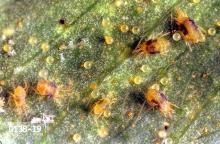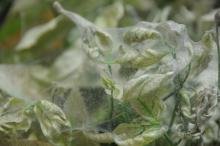Includes
Pacific spider mite (Tetranychus pacificus)
Strawberry spider mite (Tetranychus turkestani)
Twospotted spider mite (Tetranychus urticae)
Pest description, crop damage and life history
See:
Common Pests of Vegetable Crops
Pest monitoring There is no precise survey technique for evaluating spider mite infestations in snap beans. Infestations usually begin on the lower portions of the plants and move upward as mite numbers increase. Evaluating spider mite infestations is most efficient if older, lower leaves are selected at random and inspected for stippling on the upper surface and webbing, mites, and feeding scars on the lower leaf surface.
Management-biological control
Spider mite populations may be held at very low levels by a number of insect and mite predators, particularly early in the year. Thrips feed on spider mite eggs; they are effective early year predators. Predatory mites are used to control spider mites in strawberries and in greenhouses. The impact of releasing commercially produced predatory mites in snap beans is untested. Spider mites provide an important food source for predators such as minute pirate and bigeyed bugs.
Management-cultural control
Minimizing early year insecticide applications, which tend to reduce populations of beneficial insects, will reduce spider mite outbreaks. Spider mite problems can be reduced by keeping fields and field margins clean of weed hosts. Spider mite populations increase more rapidly in areas where dust deposits are heavy. Reducing dust may reduce the spider mite problem. Excessive nitrogen fertilization may contribute to population buildup.
Management-chemical control: HOME USE
- azadirachtin (neem oil)-Some formulations are OMRI-listed for organic use.
- bifenthrin
- insecticidal soap-Complete coverage of upper and lower leaf surfaces important. More than one application may be required. Some formulations are OMRI-listed for organic use.
- plant essential oils (such as cottonseed, clove and garlic oils)-Some formulations are OMRI-listed for organic use.
- sulfur (usually as a mix with pyrethrins)-Some formulations are OMRI-listed for organic use.
Management-chemical control: COMMERCIAL USE
- abamectin (Agri-Mek SC) at 0.019 lb ai/A. PHI 7 days. REI 12 hr. Non-ionic surfactant required. Do not exceed 0.056 lb ai/A per season. Limit 2 treatments.
- acequinocyl (Kanemite 15SC) at 0.3 lb ai/A. PHI 7 days. REI 12 hr. Retreatment interval 21 days. Do not exceed 0.6 lb ai/A per season.
- bifenthrin (Sniper) at 0.08 to 0.1 lb ai/A. PHI 3 days. REI 12 hr. Do not exceed 0.2 lb ai/A per year.
- bifenthrin/zeta-cypermethrin (Hero EW) at 0.1 lb ai/A. PHI 3 days. REI 12 hr. Retreatment interval 5 days. Do not exceed 0.266 lb/A per season.
- bifenazate (Acramite 50WS) at 0.5 to 0.75 lb ai/A. PHI 3 days. REI 12 hr. Do not exceed two treatments per season.
- dimethoate (Dimethoate 400 EC) at 0.5 lb ai/A. PHI 0 days if mechanically harvested. REI 48 hr. Retreatment interval 14 days. Do not exceed 1.0 lb/A per year. Do not feed vines or hay.
- fenpyroximate (Miteus) at 0.105 lb ai/A. PHI 1 day. REI 12 hr. Limit 2 treatments. Do not exceed 0.21 lb ai/A per season. Retreatment interval 14 days.
- hexythiazox (Onager) at 0.078 to 0.188 lb ai/A. PHI 14 days. REI 12 hr. One treatment per year. Do not harvest or graze bean vine forage or hay.
- Isaria fumosorosea (PFR-97 20%WDG) at 1 to 2 lb product per acre. PHI 0 days. REI 4 hr. Repeat every 3 to 10 days as needed. OMRI-listed for organic use.
- naled (Dibrom 8) at 0.94 lb ai/A. PHI 1 day. REI 48 hr. Retreatment interval 7 days. Do not exceed 5 treatments per season.
- phorate (Thimet 20G) at 1.5 lb ai/A. PHI 60 days for forage. REI 48 to 72 hr. At planting time only. Do not graze or feed to livestock. Extremely toxic to fish and wildlife.
- sulfur at 2.25 to 6.75 lb ai/A. PHI 0 days. REI 24 hr. Some formulations are OMRI-listed for organic use.



